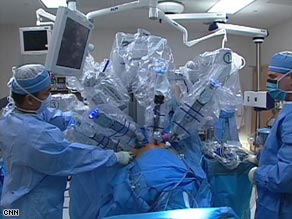CNN
(CNN) -- NASA's Phoenix lander has discovered a toxic chemical in soil near Mars' north pole, dimming hopes for finding life on the Red Planet, the probe's operators said Monday.

The Phoenix lander's inverted scoop prepares to take soil samples on Mars in this undated image.
The chemical, perchlorate, is an oxidant widely used in solid rocket fuel. Researchers are still puzzling over the results and checking to make sure the perchlorate wasn't carried to Mars from Earth, the University of Arizona-based science team said.
"While we have not completed our process on these soil samples, we have very interesting intermediate results," Peter Smith, the principal investigator for the project, said in a written statement.
Early readings from a device aboard Phoenix called the Microscopy, Electrochemistry and Conductivity Analyzer, or MECA, "suggested Earth-like soil," Smith said.
"Further analysis has revealed un-Earthlike aspects of the soil chemistry," he said.
The Phoenix team has scheduled a teleconference for Tuesday to discuss the findings.
"Oxidizing" soil conditions also were found at the Viking 1 and 2 landing sites in the 1970s, leading most scientists to conclude that there could be no life there.
NASA's Odyssey orbiter first reported in 2001 that the planet's arctic plain was rich in water ice, mostly in the form of permafrost. Since the Phoenix lander touched down in May, robotic instruments on the craft have been collecting and analyzing soil samples, looking for organic compounds that would indicate Mars is or was able to support life.
The new findings from Phoenix cast into further doubt the possibility that life exists on Mars' surface. But they do not rule out the possibility that life once existed, nor do they necessarily rule out the possibility of life existing now, perhaps in a deep underground aquifer.
Phoenix's MECA instrument was designed to run four experiments on Mars' soil, testing for such characteristics as acidity and the presence of various compounds, minerals and salts. The science team has completed two MECA runs on soil, and perchlorate did not turn up in the first experiment.
The Phoenix team are continuing to use MECA and another instrument called the Thermal and Evolved-Gas Analyzer, or TEGA, to look for organic chemicals. TEGA can also detect the presence of perchlorate, but so far has not done so.
NASA also announced last week that the Phoenix mission has been extended to the end of September. The mission could be extended again if it is operational then, but the harsh Martian winter will bring it to an end if nothing else does, probably around November.









